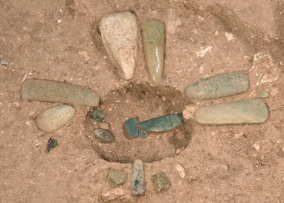SYLLABUS
Prelims GS Paper 1: Current events of national and international importance
Context: The 3,000-year-old ceremonial complex of Aguada Fenix in Tabasco was designed as a monumental “cosmogram” according to new research by Archaeologists.
Location and Size
- It is located in Tabasco, Mexico, near the Guatemala border.
- It stands as the largest and oldest known Maya ceremonial site.
- It measures nearly a mile long (1,400 meters) and a quarter-mile wide.
- Its total volume exceeds that of the Great Pyramid of Giza (3.2–4.3 million cubic meters).
Age and Construction
- It dates back tobetween 1000 and 800 BCE.
- It was built through successive construction events that layered different types of soil.
- Its construction required an estimated 10–13 million person-days of labours.
- It was constructed by a non-hierarchical, cooperative society.
Architectural Features

- It forms a large cosmogram representing theMaya model of the universe.
- It features a large cross-shaped (cruciform) pit containing ceremonial caches.
- Pigments found in the pits correspond to the four cardinal directions – north (Bright blue azurite), south (yellow ochre), east (green malachite), and west (pearly seashells) – and are believed to be the oldest-known examples of such directional colour symbolism in Mesoamerica.
- It includes nine massive causeways and water canals extending up to six miles.
- Its centreline aligns with the sunrises on October 17 and February 24, reflecting the Maya 260-day ritual calendar.
- It incorporates reservoirs, raised causeways, sunken corridors, and a dam.
Cultural and Social Significance
- It shows no evidence of social hierarchy, such as palaces or tombs.
- It demonstrates that communal work and shared rituals formed its foundation.
- It contains artifacts including ceremonial jade axes, shells, bones, and ceramics.
- The Jade sculptures rather than glorifying gods or rulers, depicts natural events and daily life, including a woman giving birth called ‘jade woman’.
- It emphasizes advanced spiritual, astronomical, and calendrical knowledge, providing major insights into early Maya cosmology, rituals, and social organization.
- The cruciform shapes and colour symbolism encoded in the architecture are the physical embodiment of notions of how the earthly plane was organised, governed by the cardinal directions.
Archaeological Importance
- It challenges earlier models that proposed Maya complexity evolved from elite domination. Rather than being imposed by a privileged elite, the builders may have belonged to an egalitarian, cooperative society interested in communal rituals, astronomical observations, and calendar keeping.
- The dam and canals highlight the importance of water both practically and symbolically, which is also reflected in the blue/green pigments, shells, and greenstone offerings.
- It demonstrates early Maya social equality and large-scale collective labour.
- It reveals extensive inter-regional cultural exchanges with the Olmec and other Mesoamerican groups.
Archaeological Techniques used:
- It was discovered using LiDAR aerial survey technology.
- It has been excavated by multidisciplinary teams, including the Middle Usumacinta Archaeological Project.
- Radiocarbon dating and ceramic analysis have established its chronology.

